
ilovepancakes
-
Posts
175 -
Joined
-
Last visited
-
Days Won
2
Posts posted by ilovepancakes
-
-
15 hours ago, ThorGroup said:
1) Do you get something like "error: failure writing sector 0x20ba to 'hd0" in grub when you pick the boot option (followed by "Loading Linux..." and "Loading initramfs...")? Because if it doesn't remember it means it's unable to save the grub environment to a disk. In such case your VMDK may be read only.
No, output in Grub seems normal, despite reverting to USB option each time I boot. See below. For what it's worth, after installing DSM, using the USB boot entry does indeed boot DSM, with the only side effect being the loader VMDK shows up in Storage Manager as Disk 1. If I use SATA boot option, loader doesn't show up in DSM at all and the first data VMDK shows up as Disk 2 in Storage Manager.
15 hours ago, ThorGroup said:3) This seems to be related to the hddmon problem and SMART discussion above
I agree it seems to have something to do with hddmon as far as I can see so far. I was looking at some of the files for the Storage Manager interface and DSM makes some requests when opening Storage Manager health info that references "hddmon". Not entirely sure though.
Side Note: You guys have any crypto addresses that can accept some beer/pizza money? 🍕🍻
-
10 minutes ago, Aigor said:
Storage manager MUST read smart data
From everything I have seen, this isn't the case. On Jun's loader, virtual disks don't show SMART data of course and the logs still complain about that, but the disk is still marked "Healthy" which makes it usable in a storage pool. I'm assuming Jun did something with the loader to get virtual disks to mark that way. That is, DSM determines if a disk can be used or not by the health status. It certainly is possible that the health status is determined by SMART data being present and readable, BUT if you find a way to override the health status flag and force it to "Healthy", the disk will be usable in Storage Manager even though SMART data is not present and DSM still says it can't be accessed.
On Jun's loader, notice how even though the disk is marked "Healthy" when you click "Health Info" for that disk, it doesn't load any SMART data, even fake SMART data or something. It says "access error". Also certainly possible they completely changed how that works in DSM 7, but the way to test is to spin up 6.2.4 with Redpill and see if the same issue happens on ESXi. If it does, then we know the loader is what is missing something to correctly trick DSM into using the virtual disks. I opened an issue on Redpill-LKM github repo for @ThorGroup to evaluate further.
-
1 hour ago, ThorGroup said:
SATA boot is here
Nicely done!! I built a fresh lkm and loader and can successfully install DSM 7 on ESXi now! A couple of things I noticed from a first run...
1.) The Grub boot menu doesn't seem to remember the "SATA" boot option as the last chosen option. When I reboot the VM, it defaults back to USB.
2.) Within DSM, if I go to Info Center under Control Panel, the "General" tab doesn't load, it just is white and shows no info about DSM.
3.) The only way I got the install to work was to have the loader VMDK and the data VMDK on the same SATA controller. If loader is on a SCSI controller for the VM, it boots but gets error 13 again. If I move loader to SATA controller along with a data VMDK, it installs, BUT I cannot create a storage pool/volume in DSM. Storage Manager shows the Vmware SATA drive but DSM says it cannot detect the drives status as "Healthy" so it won't let that drive be used to create a volume. I know SMART doesn't work with Xpenology and ESXi, but in Jun's loader the virtual drives at least showed "Healthy" which meant DSM could use them.
Any insight or testing you have done on your end to make it work? Here are some photos.
-
2 minutes ago, haydibe said:
Yep, hours of trial and error saves you from reading previous forum posts ^^
It's alway nice to get a recap of already established experience from people that tl;dr the previous posts

Mods, perhaps a sticky on top of this thread reiterating it's for dev use only right now and VMware products are not bootable yet with redpill?
-
 1
1
-
-
1 minute ago, havast said:
Hi All!
First of all, thank you devs for the hard work, you are keeping this project alive, nice!
Second: I would like to test DSM7 on my ESXI host. Anyone can build a 3615xs or 3617xs loader for me, if i give SN and MAC for it? Sure i would donate a few beer for the help

Thanks for the help!
Read some of the above thread. ESXi will not work per TTG until they implement SATA DOM fixes.
-
9 minutes ago, ThorGroup said:
As for VBox you're probably missing https://github.com/RedPill-TTG/redpill-load/commit/5df3ace2191f6bad818b2f34e802163a96408d59 - yumkey branch doesn't have that commit. We're working on v7 but we found some problems (e.g. broken cmdline sanitization which may trigger autodestruction of the DSM after a random time).
@jumkey seems to have added that commit to his branch today (https://github.com/jumkey/redpill-load/commit/e071f75e9918f9b27211cc51f87f3d046de1dc6d) and I confirmed the below is the full file on my system after downloading his branch and building a loader with it, but I still get no network connection from the VM in Virtual Box when I try to find loader with "find.synology.com" or by checking DHCP server entries for the assigned mac address.
lab@debian8-lab01:~/redpill-DSM7/redpill-load/config/DS918+/7.0-41890$ cat ramdisk-002-init-script.patch --- a/linuxrc.syno.impl +++ b/linuxrc.syno.impl @@ -3,6 +3,8 @@ echo "START /linuxrc.syno.impl" +insmod /usr/lib/modules/rp.ko && rm /usr/lib/modules/rp.ko + . /etc.defaults/rc.subr . /usr/syno/share/environments.sh . /usr/syno/share/util.sh @@ -138,6 +140,7 @@ fi # insert basic USB modules for detect f401/FDT echo "Insert basic USB modules..." SYNOLoadModules $USB_MODULES +SYNOLoadModules "usb-storage" # insert Etron USB3.0 drivers @@ -252,7 +255,7 @@ if [ "x" != "x`/bin/get_key_value /etc.d fi if [ "$UniqueRD" = "kvmx64" -o \ "$UniqueRD" = "nextkvmx64" -o \ - "$UniqueRD" = "kvmcloud" ]; then + "$UniqueRD" = "kvmcloud" ] || (dmesg | grep -q -E "DMI: .*(QEMU|VirtualBox)"); then insmod /lib/modules/virtio.ko insmod /lib/modules/virtio_ring.ko insmod /lib/modules/virtio_pci.ko lab@debian8-lab01:~/redpill-DSM7/redpill-load/config/DS918+/7.0-41890$
-
25 minutes ago, ThorGroup said:
Synoboot device can be:
- A USB stick with the correct vendor-id/product-id combo
For ESXi, since it can't virtualize USB sticks, what about a way in the loader to trick DSM into seeing the SATA virtual disk as a USB stick? It seems now DSM detects the SATA disk as a SATA disk based on those errors in messages log upon install, but it something was shimmed to make it appear as a USB with valid VID/PID maybe that would be a solution?
Also, while waiting for ESXi to work with Redpill I started experimenting with VirtualBox and I get Redpill (using Jumkey's latest branch for 7.0 (which does now take your updated virtio networking fix into account for VirtualBox) to boot and show a console but it doesn't seem to grab an IP, only shows "lo" network, no "eth0". Here is messages log, any ideas?
-
1 hour ago, Aigor said:
I'm not full understood sata dom use.
My test boots flawless and recognize sata virtual hdd , but cant install DSM into sata disk.Known problem, not fixed easily other than updating Redpill to support SATA DOM (small SATA based chip where DSM boots from in some actual Synology devices) which TTG is working on.
-
 2
2
-
-
6 minutes ago, Aigor said:
Yes it works for me, i use esxi-7.02 with Vcenter, it boots and reach prompt in serial, sysnology assistant show me new system, start installation of DS3615xs 7.0 pat file, but it ends with error 13 at almost 45% on webinterface
What does /var/log/messages show as failure for install?
-
17 hours ago, Aigor said:
Download plip
https://download.plop.at/files/bootmngr/plpbt-5.0.15.zip
unzip, you obtain a iso file, connect them to VM as boot CDROM
when usb-key is ready, put it into esxi host, on VM add usb host device and you should see usb key.
Boot with plip, at prompt, boot usb and you can boot vm from image into usb key.This was the method I was talking about in earlier posts that doesn't work for me.... you are able to boot a physical USB this way? It definitely boots? When I choose the USB stick in plip the screen just freezes and it never boots. If you are able to boot the USB do you still get Error 13 on install or DSM installs and actually works?
-
2 hours ago, flyride said:
Not sure why I was able to do it but it was some time ago. I suspect it's a legacy boot vs. EFI BIOS configuration (which then implies DS918+ for Jun's loader).
In any case, here's a current solution: https://www.virtualizationhowto.com/2019/01/boot-esxi-virtual-machine-from-passthrough-usb/
This was the link/solution I was posting about in the original post you replied to saying it works lol. Even with that bootloader ISO, it does not boot, the bootloader freezes.
-
8 minutes ago, flyride said:
Recounting this from memory, but I have actually done this. Specifically, configured a passthrough USB as the Jun bootloader for a VM which worked fine.
It probably was under ESXi 6.5, so maybe it's a hardware profile problem. Try building an ESXi 6.5 VM (virtual hardware version 13) and see if that helps.
Just tried hardware version 13 with a USB 2.0 and then 3.1 controller, no dice. The can be attached to the VM okay but doesn't show up in BIOS boot menu at all.
-
31 minutes ago, flyride said:
Sure it can. You just have to go into the BIOS during boot and set it up.
Right, but BIOS shows "Removable Devices" under boot options but doesn't list the USB on there, it just doesn't show up at all. If I use the method at that link, that ISO based bootloader does show the USB, but won't boot off it. If you have a way to get ESXi to directly show a physical USB device in the VM BIOS, would love to know so I can try RedPill that way.
-
6 minutes ago, pocopico said:
What if you attach and boot from a real USB stick (burned with the correct image) ?
I tried this with ESXi and passing through the USB stick. Apparently, ESXi can't boot from any USB pass through devices. And I tried a method that uses a simple bootloader ISO first (https://www.virtualizationhowto.com/2019/01/boot-esxi-virtual-machine-from-passthrough-usb/) which then creates a boot menu on the screen that does show the physical USB as an option, but when I select it, the screen freezes and nothing happens.
-
4 hours ago, ThorGroup said:
RedPill actually blocks telemetry as well

This is awesome, although I am wondering, does it block all synology domains? For example, I created a patch that allows push notifications to work, so does RedPill-LKM block anything going out to *.synology.com, etc. or just the domains known to do telemetry, like Active Insight? (https://kb.synology.com/en-my/DSM/tutorial/What_websites_does_Synology_NAS_connect_to_when_running_services_or_updating_software).
Also, how is this blocking done? Host file or something?
-
3 hours ago, RedwinX said:
Hi,
This is the log file (/var/log/message) from ESXi (error 13)
logfile.txt 38.88 kB · 6 downloads
Think this error is the root cause :
Aug 3 10:55:20 updater: boot/boot_lock.c(228): failed to mount boot device /dev/synoboot2 /tmp/bootmnt (errno:2)
Aug 3 10:55:20 updater: updater.c:6252 Failed to mount boot partition
Aug 3 10:55:20 updater: updater.c:3013 No need to reset reason for v.25556@ThorGroup Per your request for my messages log, confirming this one by @RedwinX is the same result I get now that we solved why I wasn't getting a console login prompt. Tried with a DSM 7 loader and .ko file also and same result on ESXi, can't finish install, get Error 13 with above log. Opened an issue on Github for it, but if you'd rather keep it here, let me know.
-
41 minutes ago, ThorGroup said:
Can you also try tapping Ctrl+D (even if you're on a Mac still use Ctrl). It should trigger restart of the login process.
No dice. Console still seems to hang at that last line and won't present a login prompt despite the VM being okay otherwise. Here is my hardware config. I am running ESXi 7.0.1, build 17551050. I also tried with USB 2.0 controller instead of 3.1. The NIC is e1000e. The 128MB loader HDD is SCSI and the 50GB HDD is SATA. I couldn't seem to get DSM install wizard to find an HDD unless it was SATA.
-
8 minutes ago, smoojay said:
yes, the core os is already part of the image which you will get with the the redpill-loader
OK, I confirmed then the console is hanging after that last line and not showing a login prompt, despite the syno web interface still working and the VM being up. @ThorGroup because of that, can I get the /var/log/messages you requested another way or any idea why console is hanging after that line? This is the output of that 3rd serial port where console should show up: https://pastebin.com/nvVTtVC2
That shows from boot of VM to after I receive the Error 13, but as you can see, no login prompt ever shows up on console and hitting enter doesn't do anything.
-
17 minutes ago, smoojay said:
after successful boot, you should see something like
.. :: Loading module hid ... [ OK ] :: Loading mo[ 46.880017] usbcore: registered new interface driver usbhid dule usbhid[ 46.905318] usbhid: USB HID core driver ... [ OK ] :: Loading module syno_hddmon ... [FAILED] ============ Date ============ Wed Jul 28 15:38 Wed Jul 28 15:38:09 2021 DiskStation login:then you are sure you are at the right port. sorry i don't know other ways to access the log.
This is exactly what I remember getting from Jun's loader, but I'm not seeing that login prompt here. To confirm, I am supposed to get that prompt even before DSM is actually installed? @ThorGroup requested my logs because I am getting the "File Corrupted" Error (13) message when trying to install DSM via redpill-load. If I am supposed to get that login before DSM is actually installed, then yeah I tried 3 serial ports at same time so far. 1st one shows initial boot then stops, 2nd shows 3 lines of gibberish, 3rd shows remaining boot process but then ends at "[ 29.157663] usbhid: USB HID core driver" and hitting enter doesn't bring up a login prompt.
-
6 minutes ago, smoojay said:
You can login using the serial interface
Hmm, I'm on ESXi and that is what I thought because in past with Jun's loader I add a serial port to VM then telnet to it and can access console. When I do that now though (added 3 serial ports total to see all outputs), I can see the console outputs and boot process but can't get a login prompt to show up. And I supposed to see the prompt somewhere else?
-
10 hours ago, ThorGroup said:
Can you post the full install log from /var/log/messages?
Where do I access this?
-
3 minutes ago, scoobdriver said:
Unless qemu-utils is an option.
Never used it but from a quick search, it might. https://stackoverflow.com/questions/454899/how-to-convert-flat-raw-disk-image-to-vmdk-for-virtualbox-or-vmplayer
-
2 hours ago, ThorGroup said:
As @smoojay mentioned this is the output from ttyS0 and ends up as expected - rest of it will be on ttyS1 for Linux v3 or ttyS2 for Linux v4.
This is an issue with how synobios and DSM kernels are handling serial ports. There's a plan to make it work properly with 2 serial ports attached and "redirect" synobios to ttyS1. The current state is a byproduct of being a pre-alpha
Ahh okay, here is my serial output from the 3rd serial port I added to ESXi: https://pastebin.com/nvVTtVC2
I re-compiled using Debian 8 and GCC-4.9 like recommended to make sure I have a perfect loader and I still get the file corrupted error 13 message when it gets to 56% on "Installing DSM...".
1 hour ago, scoobdriver said:Those who are testing on ESxi , could you explain how you are doing this , I have created the redpill .img file . using the steps provided for DS918+
not sure how I then boot this from ESXi ( I have tried using the vmdk for the previous loader , however that was unsuccessful )
Thanks
Convert the .img file to VMDK file using Starwind V2V Converter. It is free download on their site. Choose the options in there for ESXi compatible VMDKs then upload those and boot of that.
-
6 hours ago, smoojay said:
see ttyS2 for the console output
How do I get to this? I added two more serial ports (3 total) to the VM and #3 gets a different output than the #1 I posted above. #2 gets no output. Not sure if I am looking in right spot. I'm on ESXi.
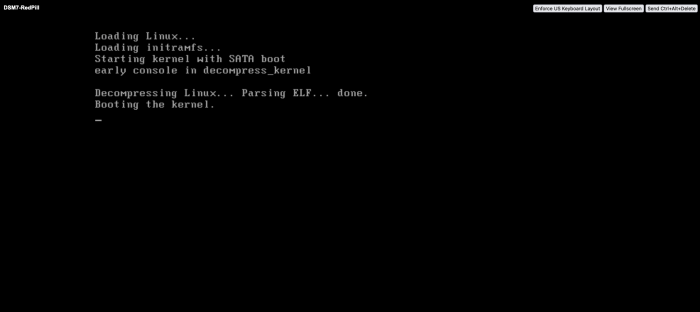
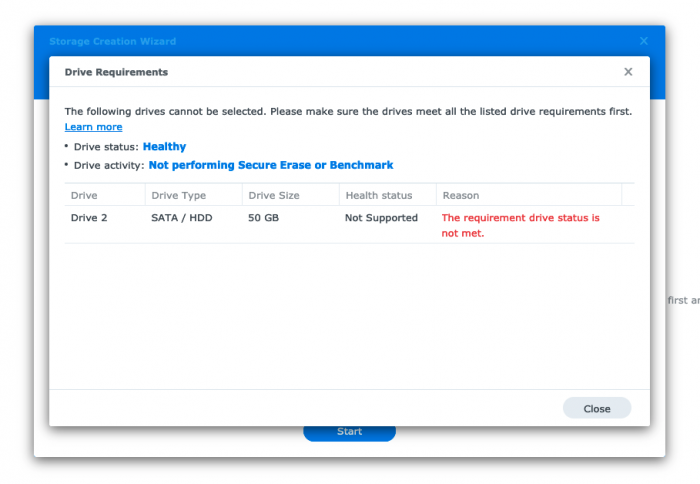
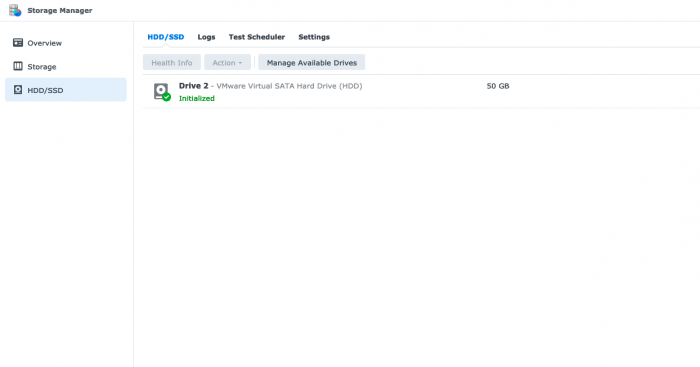
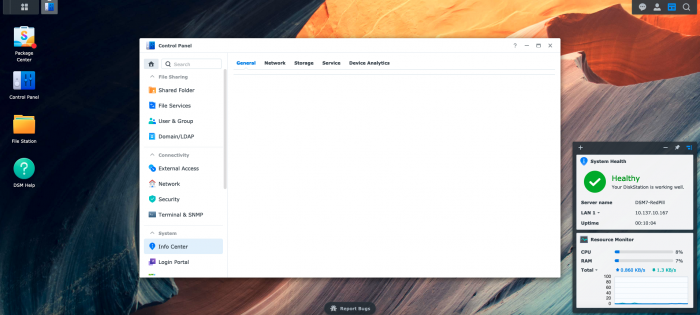
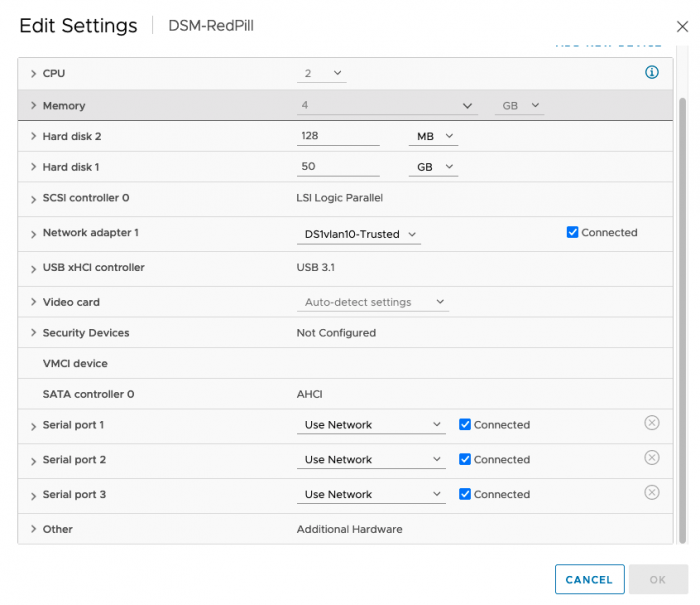
RedPill - the new loader for 6.2.4 - Discussion
in Developer Discussion Room
Posted
Generated new image with latest redpill-load and saving of the boot option does not work still.